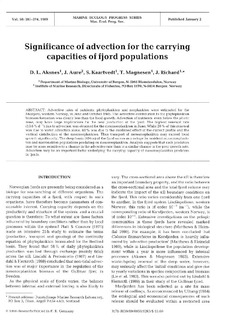Significance of advection for the carrying capacities of fjord populations
Journal article, Peer reviewed
Permanent lenke
http://hdl.handle.net/11250/108637Utgivelsesdato
1989-02-02Metadata
Vis full innførselSamlinger
- Articles [3012]
Originalversjon
http://dx.doi.org/10.3354/meps050263Sammendrag
Advective rates of nutrients, phytoplankton and zooplankton were estimated for the
Masfjord, western Norway, in June and October 1985. The advective contribution to the phytoplankton
biomass formation was dearly less than the local growth. Advection of nutrients, even below the photic
zone, may have large implications for the new production of the fjord. The highest renewal rate
(13.6 % d l ) due to advection was obtained for the mesozooplankton in June. While 20 % of this renewal
was due to water advection alone, 80 % was due to the combined effect of the current profile and the
vertical distribution of the mesozooplankton. Thus transport of mesozooplankton may exceed local
growth significantly. The deep basin (494 m) of the fjord serves as a refuge for resident macrozooplankton
and rnicronekton populations predating on mesozooplankton. Analysis suggests that such predators
may be more sensitive to a change in the advective rate than to a similar change in the prey growth rate.
Advection may be an important factor underlying the carrying capacity of mesozooplankton predators
in fjords.
